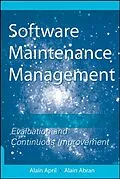This book explores the domain of software maintenance management and provides road maps for improving software maintenance organizations. It describes full maintenance maturity models organized by levels 1, 2, and 3, which allow for benchmarking and continuous improvement paths. Goals for each key practice area are also provided, and the model presented is fully aligned with the architecture and framework of software development maturity models of CMMI and ISO 15504. It is complete with case studies, figures, tables, and graphs.
Autorentext
Alain April, PhD, is Professor of Software Engineering at
Université du Québec (Canada). His research interests
include software maintenance, software quality assurance, and
multimedia databases. Dr. April has worked in the
telecommunications industry for more than twenty years, has
contributed to the internal measurement of software of ISO 9126-3,
and is an Editor of The Guide to Software Engineering Body of
Knowledge (SWEBOK) chapters on software maintenance and
software quality.
Alain Abran, PhD, is Professor and the Director of the
Software Engineering Research Laboratory at Université du
Québec (Canada). Dr. Abran is the Co-Executive Editor of the
SWEBOK project. He has been actively involved in software
engineering standardization as the International Secretary for
ISO/IEC JTC SC7 Software and System Engineering and as co-manager
for the Common Software Measurement International Consortium
(COSMIC). Dr. Abran's research interests include software
productivity and estimation models, software engineering
foundations, software quality, software functional size
measurement, software risk management, and software maintenance
management.
Klappentext
The only authoritative reference to provide a management perspective of software maintenance
Software maintenance accounts for 6090% of software life-cycle costs, and unfortunately, very little attention is given to software maintenance education, training, and research. Now, two experts in the field explain how understanding software maintenance, implementing best practices, and improving its processes can help software managers to dramatically cut costs.
Software Maintenance Management explores the domain of software maintenance management and provides road maps for improving software maintenance organizations. It describes full maintenance maturity models organized by levels 1, 2, and 3, which allow for benchmarking and continuous improvement paths. Goals for each key practice area are also provided, and the model presented is fully aligned with the architecture and framework of software development maturity models of CMMI and ISO 15504.
Complete with case studies, figures, tables, and graphs, Software Maintenance Management fills the need for a comprehensive and authoritative reference on the subject for maintenance managers, software managers, systems analysts, quality managers, and quality analysts. It alsoserves as a valuable textbook for advanced undergraduate and graduate courses in softwareengineering, software maintenance, software process improvement, and software benchmarking.
Inhalt
Foreword xiii
Thomas Pigoski
Foreword xv
Ned Chapin
Preface xvii
1 Maintenance Issues and Related Management Approaches 1
1.1 Introduction 1
1.2 Issues in Software Maintenance 2
1.2.1 Users' Perceptions of Software Maintenance Issues 2
1.2.2 Maintainers' Perceptions of Software Maintenance Issues 4
1.3 Software Maintenance Body of Knowledge 8
1.4 Software Maintenance Definition 10
1.5 Differences Between Operations, Development, and Maintenance 10
1.6 Which Organization is Responsible for Software Maintenance? 15
1.7 Software Maintenance Standards 15
1.8 Software Maintenance Process and Activities 21
1.9 Software Maintenance Categories 23
1.10 Maintenance Measurement 23
1.10.1 Maintenance Process Measurement 23
1.10.2 Software Product Measurement 28
1.11 Service Measurement 29
1.11.1 Internal Service-Level Agreement 30
1.11.2 Maintenance Service ContractsExternal Service Agreement 32
1.11.3 Outsourcing Agreements 34
1.12 Software Maintenance Benchmarking 35
1.13 Summary 37
1.14 Exercises 38
2 Maturity Models in Software Engineering 41
2.1 Introduction 41
2.2 Overview of Basic Concepts (Process and Maturity) 42
2.3 Does CMMi Cover Software Maintenance Adequately? 45
2.4 Difference Between Maturity Model, Quality Standards, and Evaluation Method 46
2.4.1 Choosing Between ISO9001 and CMMi 46
2.4.2 The Evaluation Method 48
2.4.3 Evaluation Types 51
2.5 How is a Maturity Model Designed? 52
2.5.1 The Trillium Design Process 52
2.5.2 ISO 15504 Design Process 54
2.5.3 CMMi for Services Design Process 55
2.5.4 Summary 55
2.6 Initial Validation of a Maturity Model 55
2.6.1 IT Service CMM ModelInitial Validation Approach 56
2.6.2 CM3® ModelInitial Validation Approach 56
2.6.3 ISO 15504 ModelInitial Validation Approach 57
2.6.4 CMMI for Services ModelInitial Validation Approach 57
2.6.5 Maturity Model Validation, Conclusion 57
2.7 What is the Typical Architecture of Maturity Models? 57
2.7.1 CMMi Model Architecture 58
2.7.2 The ISO 15504 (SPICE) Model 60
2.8 An Inventory of Software Engineering Maturity Models 62
2.9 Summary 65
2.10 Exercices 66
3 Foundations of the S3m® Process Model 69
3.1 Introduction 69
3.2 Context of Software Maintenance 71
3.3 Proposed Classification of Software Maintenance Processes 73
3.3.1 Software Maintenance Operational Processes 75
3.3.2 Software Maintenance Support Processes 76
3.3.3 Software Maintenance Organizational Processes 76
3.4 Identification of Process Domains and Key Process Areas in Software Maintenance 76
3.5 Summary 81
3.6 Exercises 81
4 Process Management Domain 83
4.1 Overview 83
4.2 Maintenance Process Focus KPA 86
4.2.1 Goals of this KPA 86
4.2.2 Links with Other KPAs 86
4.2.3 Expected Results of this KPA 87
4.3 Maintenance Processes/Services Definition KPA 87
4.3.1 Goals of this KPA 87
4.3.2 Links with Other KPAs 88
4.3.3 Expected Results from this KPA 88
4.4 Maintenance Training KPA 88
4.4.1 Goals of this KPA 89
4.4.2 Links with Other KPAs 89
4.4.3 Expected Results from this KPA 89
4.5 Maintenance Process Performance KPA 90
4.5.1 Goals of this KPA 90
4.5.2 Links with Other KPAs 90
4.5.3 Expected Results from this KPA 91
4.6 Maintenance Innovation and Deployment KPA 91
4.6.1 Goals of this KPA 91
4.6.2 Links with Other KPAs 92
4.6.3 Expected Results from this KPA 92<...
